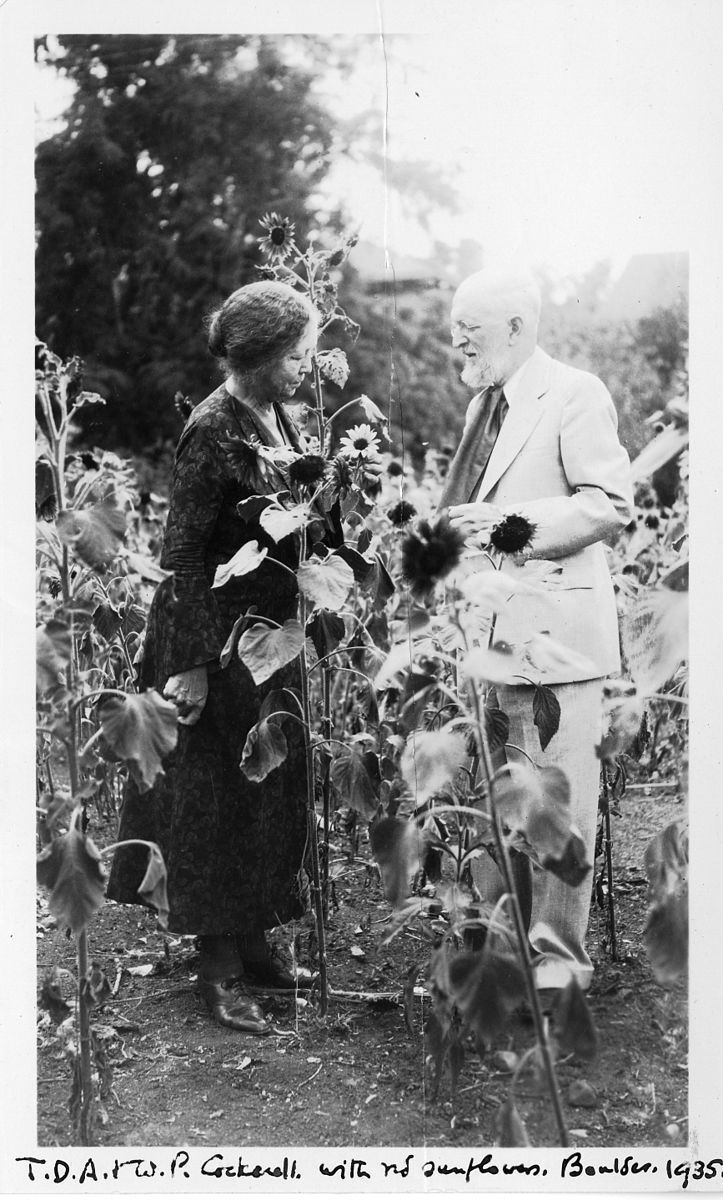Other names Wilmatte Porter Nationality American | Fields Botany, Entomology Name Wilmatte Cockerell | |
 | ||
Died 15 March 1957 aged 87
Los Angeles, Los Angeles County, California. Resting place Columbia cemetery, Boulder. Citizenship United States of America | ||
Wilmatte Porter Cockerell (1869 - January 1, 1957) was an American botanist, entomologist and teacher notable for the numerous species of fauna and flora she discovered and collected. Copious species are named in her honour.
Contents
- Biography
- Notable field trips
- Death
- Selected species named in honour of Wilmatte Porter Cockerell
- References

Biography
Cockerell was born Wilmatte Porter in Leon, Iowa, in the year 1869. She attended Stanford University and graduated from there in 1898.
From 1899 she taught biology at New Mexico Normal School in Las Vegas. There she worked with Theodore Dru Alison Cockerell who was also employed at that college. She worked jointly with him to establish an Agricultural Experiment Station.
Cockerell married Theodore on 19 June 1900. Along with undertaking her own field trips, both before and after her marriage she frequently went on collecting expeditions with Theodore. As well as field trips, she also collaborating with him on his scientific research and writing. Her support and work greatly increased the efficacy of Theodore's own career. After her marriage Cockerell continued to combine teaching with collecting, researching and writing papers. Along with her teaching career she supplemented the family income by selling specimens she obtained while on her field trips.
In 1904 Cockerell and her husband moved to Boulder, Colorado where Cockerell was employed as a biology teacher at the Colorado State Preparatory School. She continued at that high school for much of her teaching career.
In 1910 Cockerell discovered a red sunflower across the road from her home in a field. This sunflower was a mutant that she transferred to her garden and then proceeded to study and cultivate further, developing the mutation to the point where it could be sold to seed companies. Seed companies such as Peter Henderson & Co marketed the red sunflower seeds throughout the world. Cockerell was awarded a medal for her work on these sunflowers at the Panama-Pacific International Exhibition at San Francisco in 1915.
Notable field trips
In August 1902 Cockerell took a field trip to Truchas Peak Rio Arriba County, New Mexico where she collected bees and other insects. This trip resulted in the first research published under her own name, "A trip to the Truchas Peaks, New Mexico" in the journal The American Naturalist.
In 1904 Porter published a paper on rubber producing plants in Science.
In 1906 Cockerell visited Florissant with her husband, S. A. Rohwer and W. M. Wheeler, and with them collected, researched and published various articles about the fossil insects found at this site.
During the summers after 1911, the Cockerells undertook various field trips the world over collecting bees, insects, and studying the floras and fauna. During these field trips, as well as providing amply for herself and her husbands research, Cockerell's collecting also provided her fellow entomologists with copious specimens for further research and scientific publishing. As examples, in 1912 Cockerell and her husband travelled to Guatemala. There she collected numerous insect specimens including many wasps, some of which were newly discovered species previously unknown to science. These were studied by Sievert Allen Rohwer who named several new species after her. Also in 1912, while travelling in Guatemala, Cockerell collected three specimens of cacti for National Herbarium at the Smithsonian. She sent these to the botanist, Joseph Nelson Rose. One of these species he named in her honour, Wilmattea minutiflora.
In August 1918, Cockerell and her husband went on a field trip to Peaceful Valley, Colorado where again she collected specimens of numerous species previously unknown to science.
Cockerell and her husband travelled to Europe in 1921. While there, she visited the Edinburgh Garden and was present when Isaac Bayley Balfour proved that the plant Primula ellisiae was a distinct species from Primula rusbyi. This plant species was named in honour of its discoverer, and one of her husband’s students, Charlotte Cortlandt Ellis. However it appears that Balfour was in error as these plants are now regarded as being one and the same species.
In 1923 Cockerell and Theodore undertook a field trip to Japan. They travelled on the steamer Aleut. While in Japan they had a narrow escape in the Great Kantō earthquake. The Denver Times reported that Cockerell and her husband were believed lost in the catastrophe."
In the later half of 1931 into 1932 Cockerell was part of the Cockerell-Mackie-Ogilvie African scientific expedition. The expedition visited different areas of Africa including the Congo where the group collected over 16,000 specimens. Once again numerous specimens of various species were collected by Cockerell that up until then had been unknown to science.
After Theodore retired, Cockerell spent her winters with her husband in California. They both worked as volunteer curators at the Desert Museum in Palm Springs, California from 1941. They were not paid for this work but did receive housing as part compensation until 1945. In 1946 Cockerell and her husband began working at Escuela Agricola Panamericana in Tegucigalpa, Honduras. After Theodore died in San Diego, California in 1948, Cockerell taught at Piney Woods school near Jackson, Mississippi.
Death
Cockerell died on 15 March 1957 in Los Angeles, Los Angeles County, California. She is buried in Columbia Cemetery, Boulder.
